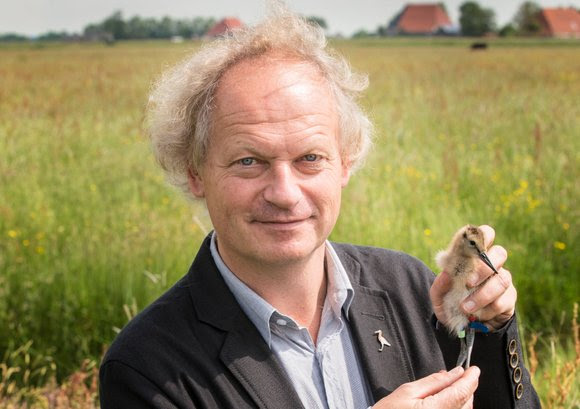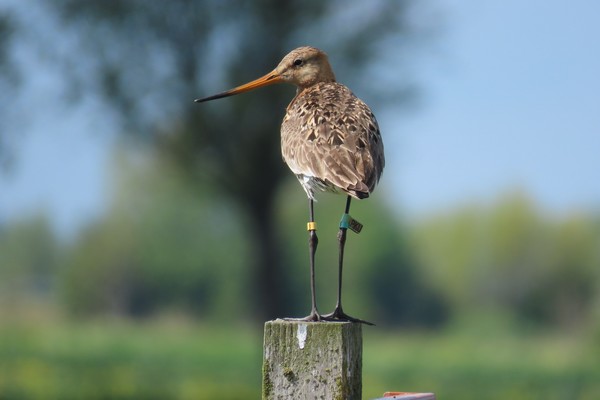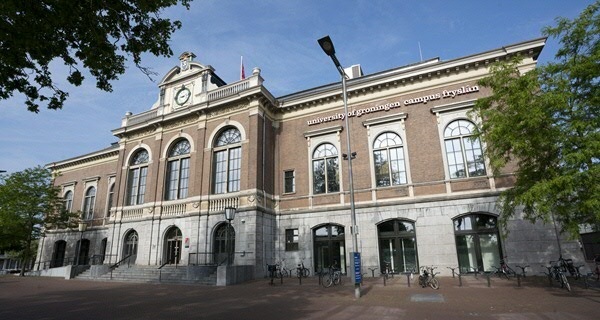Birds will tell the story of the Wadden area
Nature in the Wadden region is under pressure, but the exact consequences of climate change, tourism, environmental pollution, and rising sea levels are unknown. The University of Groningen, the Royal Netherlands Institute for Sea Research (NIOZ), and the University of Amsterdam want to find out what is going wrong and what protective measures are effective, by studying six bird species. Artists also play a role in this process.
FSE Science Newsroom | René Fransen
Professor of Migratory Bird Ecology Theunis Piersma has been investigating birds that migrate through the Wadden Sea his entire life. From West Africa to Greenland or Siberia, he has followed knots and other species. He is currently one of the driving forces behind the Waakvogels project, which will collect information on six bird species that frequent the Wadden Sea over a span of five years. In doing so, Piersma and his colleagues will continue work that started in 2012—and for some species even earlier.
(continue reading below the photo)

Catching up
‘The migratory birds tell us something about the state of the Wad,’ explains Piersma. By accurately measuring how these birds fare year in, year out, it is possible to study, for instance, the impact of climate change. ‘The sanderling, for example, did surprisingly well over the last few years. Our research showed that shrimp—an important food source for sanderlings—appear earlier on the tidal flats as a result of climate change.'
In order to uncover such trends, long-term measurements of all sorts of factors are needed. Those measurements were taken before as part of the Metawad project (2012–2016). ‘After that, the funding for such work stopped, so the project came to a halt for about seven years. Of course, we did try to continue a number of measurement series. The expensive processing and publishing, however, were no longer feasible.’ With the Waakvogels project, the work is now continuing and catching up.'
BirdEyes
Bird species that each inhabit a different biotope in the Wadden region were selected for the study. Five of them had previously been monitored as part of the Metawad project: the brent goose, which eats sea grass off the tidal flats and normal grass in polders and on the salt marshes; the sanderling, which searches for food on the tidal flats but also along the beach; the bar-tailed godwit, which mainly feeds on worms on the open Wad; the knot, which eats shellfish, and finally the spoonbill, which breeds here and forages in gullies on the Wad, but also in fresh water. The godwit has been added as a sixth species—a meadow bird that was chosen as the ‘national bird’ of the Netherlands in 2015.
(Continue reading below the photo)

Monitoring these birds is too big of a job for a normal research group. On top of that, they are migratory birds, so the areas where they spend the winter and breed also play a role. For that reason, Piersma set up the BirdEyes research centre in Leeuwarden, as an inter-faculty bridge between the Faculty of Science and Engineering and Campus Fryslân. At the centre, the UG collaborates with the Royal Netherlands Institute for Sea Research (NIOZ), the University of Amsterdam, and the Fryske Akademy.
Satellite transmitters
‘The location is very central—easy to reach from Amsterdam and from Texel, where the NIOZ is based, and close to the Wadden region,’ says Piersma. ‘And the province, the Wadden Academy, and the Wadden Fund are just around the corner. This creates a wonderful dynamic.’ BirdEyes partners are also driving the Waakvogel programme. ‘Everyone agreed that it was important for our work to continue. We now have funding for five years, and we hope to continue receiving funding after that; we aim to make our study of the population part of the Basismonitoring Waddengebied [Basic Monitoring in the Wadden region]. Almost half of the ten million euros has been designated for UG researchers.
An important part of the research takes place through transmitters: satellite transmitters that follow birds as they trek, but also temporary adhesive transmitters that are picked up by a network of antennae on the Wad, in order to monitor the daily movements. The satellite transmitters have been used for years within the Global Flyway Network programme. The adhesive ones come from the WATLAS programme initiated by the NIOZ.
(continue reading below the photo)

Siberia
The aim is not only to conduct good research—Piersma also wants to share the results in the best possible way. ‘To do this, we want to collaborate with narrative artists.’ He has done this before, for example during Oerol in 2017, where he performed together with composer and sound artist Sytze Pruiksma. ‘Within Waakvogels, we are going to organize a summer school, during which young researchers will collaborate with artists to tell the stories of their work.’ In addition, Piersma believes that artists improve the research: ‘They help us in unexpected ways to find the important questions and the main thread.’
‘On the contrary, it is inspiring to see how birds manage to adapt.’
The study focuses on the threats to the Wadden region. That sounds heavy, but Piersma sees things differently. ‘It is in fact inspiring to see how the birds are able to adapt. They can do this because they observe the world well.’ It was initially thought that the bar-tailed godwit, for example, which breeds in Siberia, would not be able to adapt well. ‘But we witnessed a continuous adaptation—the birds learned from each other, truly as a community.’
Although we know they have much to tell us, we hardly listened—far too little, in any case, to make any substantiated claims about what was actually going on in and around the Wad. ‘That’s the challenge for our project.’ The six bird species are to show what is really going on, and whether measures to protect nature are actually effective. Piersma says: ‘We want to voice the best research in the best possible way, with dynamic stories, which enrich the worlds of both human and non-human visitors to this region.’
| Last modified: | 05 September 2023 5.25 p.m. |
More news
-
24 March 2025
UG 28th in World's Most International Universities 2025 rankings
The University of Groningen has been ranked 28th in the World's Most International Universities 2025 by Times Higher Education. With this, the UG leaves behind institutions such as MIT and Harvard. The 28th place marks an increase of five places: in...
-
05 March 2025
Women in Science
The UG celebrates International Women’s Day with a special photo series: Women in Science.
-
16 December 2024
Jouke de Vries: ‘The University will have to be flexible’
2024 was a festive year for the University of Groningen. In this podcast, Jouke de Vries, the chair of the Executive Board, looks back.
